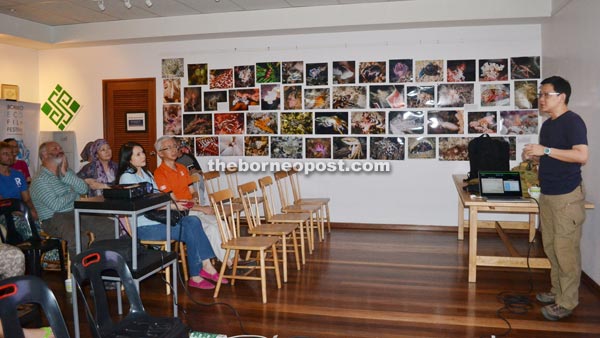
Foo talking about disaster preparedness at The Sabah Society premises.
KOTA KINABALU: People affected by the Ranau earthquake would take months or years to recover or rebuild their lives, said Eric Foo, a member of Sabah Disaster Response Network.
Therefore, people who wanted to help the earthquake victims have to bear in mind that assistance was not something they could do for only a few weekends because the needs of the victims would remain for months or years to come, he said.
Nonetheless, Foo believed that community involvement was important and could be done, such as a simple act of driving to Kundasang and buying vegetables or fruits from the locals to support their business.
“Too many keyboard commanders are complaining on Facebook and not being very constructive about it.
“I think people can come together to see what are the positive things they can do.
“It can be as simple as driving to Kundasang and buying vegetables from the people because they have no business now. Or buying fruits.”
He said this when giving a talk on disaster preparedness organized by The Sabah Society here on Tuesday.
Foo said the earthquake on June 5 had caught everyone by surprise.
“I think tourism has pretty much dropped off to nothing.”
Hence, he encouraged the people to drive up to Kundasang or Pekan Nabalu over the weekend and support the local businesses there.
On another note, Foo pointed out that a lot of people had focused on the relief part, such as the need to send water or food to the victims.
“People forget that after a disaster, people need time and help to recover and rebuild their lives, and this can take a period of as long as several months to years.”
He said a disaster could be physically and mentally challenging to the victims.
“Like the earthquake, many Ranau kids have not experienced an earthquake before.
“The guides, park staff, fire and rescue personnel and army who went up Mount Kinabalu were very challenged mentally because they were picking up body parts,” he said.
On how the authorities could have improved their response following the earthquake, Foo said nobody could have realistically planned on expecting an earthquake to happen, to be fair.
“Could the authorities improve their preparedness? Definitely.
“I am just hoping that lessons are learnt. If lessons are learnt, I think some good has come out of it.”
Nonetheless, Foo said the government had taken positive steps by recruiting mountain guides to form a search and rescue team.
“Yes, it will take time to train them (mountain guides) and all that, but I think it is a good positive step.
“As long as there is constructive criticism, people learn from it, I think something positive will come out of it.”
On the Sabah Disaster Response Network, Foo said the network was formed merely three weeks ago, prior to the earthquake, with five members.
Since then, Foo has been verifying notices about seeking assistance for Ranau earthquake victims so that donors know what the victims need, where and whom to send the contributions to.
“I have been spending a lot of time on people’s Twitter and Facebook, verifying information.
“Many people want to help, but they do not know how or what to help, so we are just trying to fill the need or gap.
“The government has a lot of resources that we do not have, but we are just trying to help and enable an average person who wants to help out like us.”
On the other hand, Foo said he and his team were trying to mobilize assessment teams to go deeper into the interior to find out the actual situation post-earthquake.
He said what he heard did not really help them or authorities in terms of taking action.
“There has to be solid assessment … some villages require a three-hour drive into Ranau, does anyone knows what happened there?
“I am trying to get that off the ground at the moment.”
On disaster preparedness, Foo said it was about having the mindset to be prepared in terms of safety, water, shelter and food.
“If you have all these things covered, you will be fairly comfortable even when a disaster happens.
“One must have a plan in preparation for disaster, which includes escape or evacuation, family communication, home preparation, special needs, preparedness skills, Go Bag and supplies,” he said.
The Go Bag is a bag containing essential items in the event of a disaster such as water supply, non-perishable food, clothing, rain gear, sleeping bag or blanket, contact information, headlamp, fire starter, map or GPS, extra medications, cash, hand sanitizer, fishing line or hook, mirror, flare, radios, work gloves, rope or cord and first aid kid.
